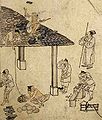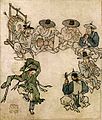Kim Hong-do
| Kim Hong-do | |
 | |
| Korean name | |
|---|---|
| Hangul | 김홍도 |
| Hanja | 金弘道 |
| Revised Romanization | Gim Hong-do |
| McCune–Reischauer | Kim Hongdo |
| Art name | |
| Hangul | [단원, 단구, 서호, 고면거사, or 첩취옹 ] Error: {{Lang}}: text has italic markup (help) |
| Hanja | [檀園, 丹邱, 西湖, 高眠居士, or 輒醉翁 ] Error: {{Lang}}: text has italic markup (help) |
| Revised Romanization | Danwon, Dan-gu, Seoho, Gomyeon-geosa, or Cheopchwiong |
| McCune–Reischauer | Tanwŏn, Tan'gu, Sŏho Komyŏn'gŏsa, or Ch'ŏpch'wiong |
| Courtesy name | |
| Hangul | 사능 |
| Hanja | 士能 |
| Revised Romanization | Saneung |
| McCune–Reischauer | Sanŭng |
Kim Hongdo, better known as Danwon (1745–c. 1806), was a painter of the late Joseon period. A member of the Gimhae Kim clan, he grew up in present-day Ansan, South Korea, where he was taught by Pyoam Kang Sehwang, one of the most famous calligraphers of the day. He entered royal service as a member of the Dohwaseo, the official painters of the Joseon court, and drew the portrait of King Jeongjo.
Danwon is known as the first Korean painter to extensively portray Korean daily life, in a manner analogous to the Dutch Masters. Because of this, his paintings today are valued almost as much for the insight they shed on daily life in Joseon as for their inherent aesthetic value.
Danwon is remembered today as one of the "Three Wons," together with Hyewon and Owon. He is also often joined to Owon and the 15th century painter An Gyeon as one of Joseon's three greatest painters.
Danwon's works are still widely treasured. The city of Ansan, where he spent his youth and learned his craft, has memorialized him in many ways. The district of Danwon-gu is named after him, as is Ansan's annual "Danwon Art Festival." Many public places have been designed in imitation of his works.
Gallery
-
"Seodang" (서당:書堂), a private elementary school in town
-
"Threshing rice" (타작:打作),
-
"Tiling giwa", Koren roof tiles (葺瓦)
-
"Fishing" (漁場)
-
"Shooting an arrow" (射弓)
-
"Dancing boy" (무동:舞童)
-
"Plowing a rice field" (논갈이:耕畓)
-
"Washing place" (빨래터:漂母)








